Week 12 out of 13 in a course about networking, and I’ve become a maniac. On Twitter, anyway. One of the course objectives was to “augment theoretical understanding of social networks with practical experience by developing, maintaining and participating in online social networks,” and I took that to heart with the best of intentions.
My plan was to concentrate on three networks: LinkedIn, Pinterest, and Twitter. However, I found that Pinterest was very time consuming and LinkedIn, due to its extremely professional constraints, left me little room to explore. For LinkedIn, I continued doing what I’d already been doing: adding contacts when I met them, posting updates from work, and liking or sharing my contacts’ posts. With Pinterest, I signed in to my more professional account, which I started as a COMM503 PLN artefact, and added a few more boards and pins to it a few times during the course.
Twitter, though, I soon realized, was my social networking home. Twitter, without any other tool (although I do use HootSuite for work and occasionally check HootSuite with my personal account) is where I shine.
I like to keep things simple. I keep Twitter open most of the time while I’m at work, because many of the accounts I follow are related to my job in some way, but aren’t appropriate for my work account to follow. When I need to cleanse my brain’s palate, I scroll through recent tweets. Over the past twelve weeks, I’ve become much more aggressive with my tweeting. I’ve become bold and outgoing! I network, not for the sake of networking, but for the sake of reaching out, bridging, making my name known to those who should know it, and sharing information with those brave enough to follow me. My followers grew from a steady 98 to 103 in this time period. It’s only an addition of five, but I’d been stuck at 98 for months, maybe years; five additional followers tells me that my networking has been successful.
Cohort member Nicole (@NicoleBasaraba) shared this infographic describing the different types of Twitter conversations one can have. Let’s see if I’ve participated in all six.
1. Divided: Discussions of polarizing topics. I tweet a lot about politics and environtmental issues, but it looks like I don’t engage in much conversation. I usually leave this sort of dialogue (or fighting) for Facebook, and use Twitter to share information.
2. Unified: Discussions within tight crowds. This is the sort of tweeting I usually participate in. For example, for school:
Or, for fun:
This is the sort of networking one does with one’s real-life or Twitter pals.
3. Fragmented: Twitter conversations revolving around brand clusters. I tweet local businesses and restaurants a lot, and get responses back. This can be a useful form of communication on Twitter as long as one is not constantly tweeting Justin Bieber or One Direction (because they probably won’t tweet you back. Sorry.).
4. Clustered: Conversations create groups clustering around global news events or popular topics, which grow into communities. Again, I sometimes send tweets that would fall under this category, but rarely engage in conversations. I think it’s wise to remove the word “global” from this category, however, because it can then be used to describe federal, provincial/state and civic twitter conversations.
5. In-Hub & Spoke: A community is created by devoted followers of news outlets, pundits, and celebrities. There is little interaction between members of the devoted, so conversation is minimal, though the network creates a distinctive star shape.
This really depends on the celebrity. Here in Edmonton, we’ve got a famous tweeting bird named Magnus, and he flirts with me when I tweet him.
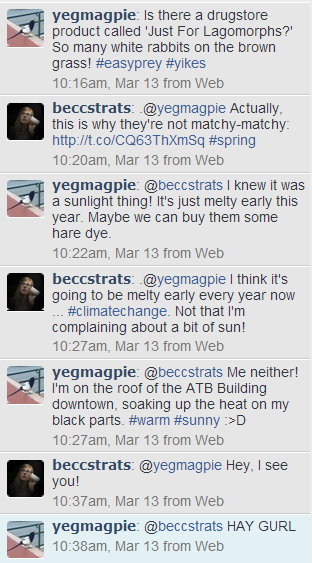 6. Out-Hub and Spoke: A twitter feed responds to complaints, requests, etc. When I get involved with this, it’s usually something like “Hey, please clean your washroom” and I tend not to get a response. But those of us who live in Alberta know we can count on @doniveson and @nenshi to respond to our tweets if we need them!
6. Out-Hub and Spoke: A twitter feed responds to complaints, requests, etc. When I get involved with this, it’s usually something like “Hey, please clean your washroom” and I tend not to get a response. But those of us who live in Alberta know we can count on @doniveson and @nenshi to respond to our tweets if we need them!
Well, I was expecting to do better. If I look at how I’d begun to categorize conversations in my rough draft of this post, before Nicole’s helpful resource twittered its way to me, I’d score much higher: I tweet for school, for bridging, for maintaining community ties, and for fun. I score pretty low in stalking celebrities, although I did engage in this gem:
How do you classify your twitter conversations? What does success look like for you?

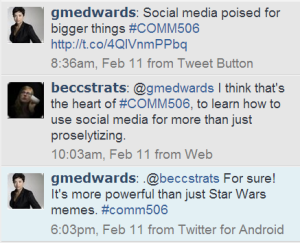
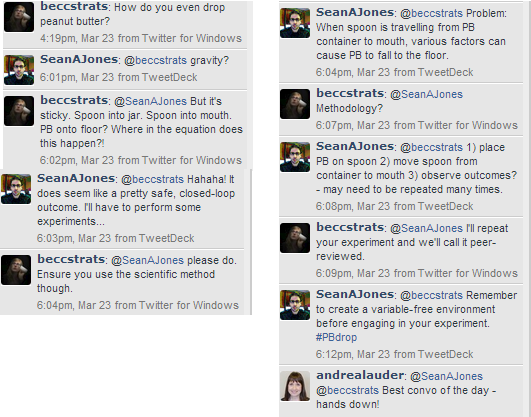

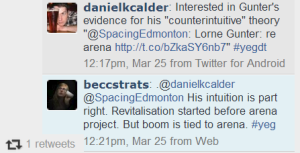
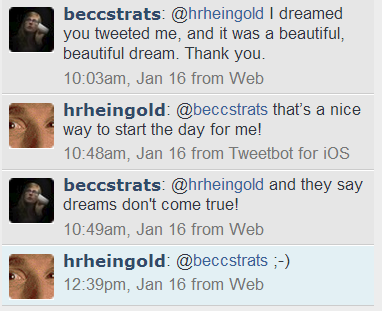
This is a great post. Thanks for the illustrated examples of the concepts we’e been learning about.
Great post Rebecca! Fun to read – and informative! I wished you tagged the @rheingold convo so the class could have seen it!